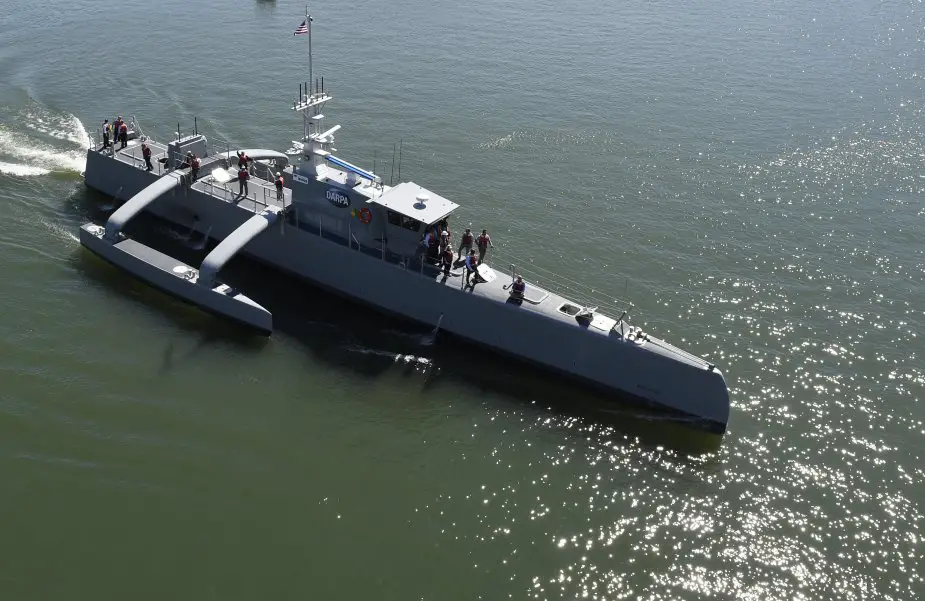Breaking news
US Navy Large Unmanned Surface and Undersea Vehicles: Background and Issues for Congress.
The Navy in FY2021 and beyond wants to develop and procure three types of large unmanned vehicles (UVs). These large UVs are called Large Unmanned Surface Vehicles (LUSVs), Medium Unmanned Surface Vehicles (MUSVs), and Extra-Large Unmanned Undersea Vehicles (XLUUVs). The Navy is requesting $579.9 million in FY2021 research and development funding for these large UVs and their enabling technologies.
 The Sea Hunter, a Medium Displacement Unmanned Surface Vehicle (MDUSV) (Picture source: US Navy/John Grady)
The Sea Hunter, a Medium Displacement Unmanned Surface Vehicle (MDUSV) (Picture source: US Navy/John Grady)
Congressional Research Service Report Summary*
The Navy wants to acquire these large UVs as part of an effort to shift the Navy to a more distributed fleet architecture. Compared to the current fleet architecture, this more distributed architecture is to include proportionately fewer large surface combatants (i.e., cruisers and destroyers), proportionately more small surface combatants (i.e., frigates and Littoral Combat Ships), and the addition of significant numbers of large UVs.
The Navy wants to employ accelerated acquisition strategies for procuring these large UVs, so as to get them into service more quickly. The Navy’s desire to employ these accelerated acquisition strategies can be viewed as an expression of the urgency that the Navy attaches to fielding large UVs for meeting future military challenges from countries such as China.
The Navy envisions LUSVs as being 200 feet to 300 feet in length and having full-load displacements of 1,000 tons to 2,000 tons. The Navy wants LUSVs to be low-cost, high-endurance, reconfigurable ships based on commercial ship designs, with ample capacity for carrying various modular payloads—particularly anti-surface warfare (ASuW) and strike payloads, meaning principally anti-ship and land-attack missiles. Although referred to as UVs, LUSVs might be more accurately described as optionally or lightly manned ships, because they might sometimes have a few onboard crew members, particularly in the nearer term as the Navy works out LUSV enabling technologies and operational concepts. In marking up the Navy’s proposed FY2020 budget, some of the congressional defense committees expressed concerns over whether the Navy’s accelerated acquisition strategies provided enough time to adequately develop concepts of operations and key technologies for these large UVs, particularly the LUSV. In response, the Navy’s FY2021 budget submission proposes to modify the acquisition strategy for the LUSV program so as to provide more time for developing operational concepts and key technologies before entering into serial production of deployable units. Under the Navy’s proposed modified LUSV acquisition strategy, the Navy is proposing to use research and development funding to acquire two additional prototypes in FY2021 and one more additional prototype in FY2022 before shifting in FY2023 to the use of procurement funding for the procurement of deployable LUSVs at annual procurement rates in FY2023-FY2025 of 2-2-3.
The Navy defines MUSVs as being 45 feet to 190 feet long, with displacements of roughly 500 tons. The Navy wants MUSVs, like LUSVs, to be low-cost, high-endurance, reconfigurable ships that can accommodate various payloads. Initial payloads for MUSVs are to be intelligence, surveillance and reconnaissance (ISR) payloads and electronic warfare (EW) systems. The Navy is pursuing the MUSV program as a rapid prototyping effort under what is known as Section 804 acquisition authority. The first MUSV prototype was funded in FY2019 and the Navy wants to fund the second prototype in FY2023.
The first five XLUUVs were funded in FY2019; they are being built by Boeing. The Navy wants to procure additional XLUUVs at a rate of two per year starting in FY2023. The Navy’s FY2021 budget submission does not include funding for the procurement of additional XLUUVs in FY2021 or FY2022.
The Navy’s large UV programs pose a number of oversight issues for Congress, including issues relating to the analytical basis for the more distributed fleet architecture; the Navy’s accelerated acquisition strategies for these programs; technical, schedule, and cost risk in the programs; the proposed annual procurement rates for the programs; the industrial base implications of the programs; potential implications for miscalculation or escalation at sea; the personnel implications of the programs; and whether the Navy has accurately priced the work it is proposing to do in FY2021 on the programs.


























